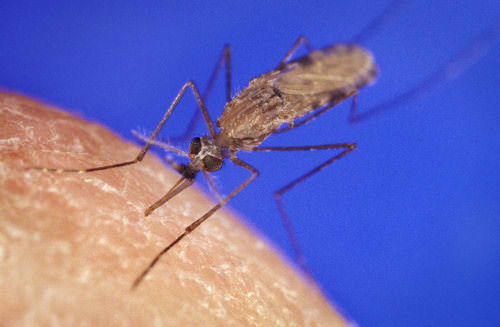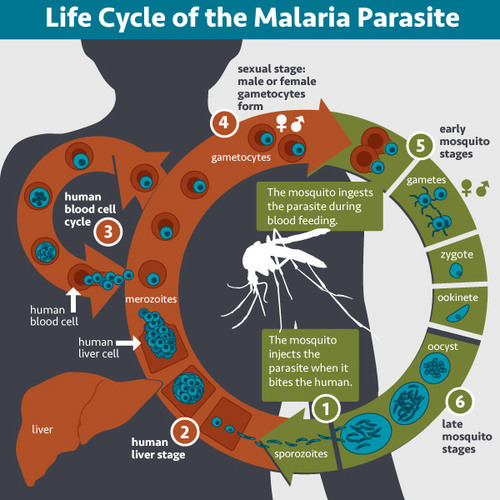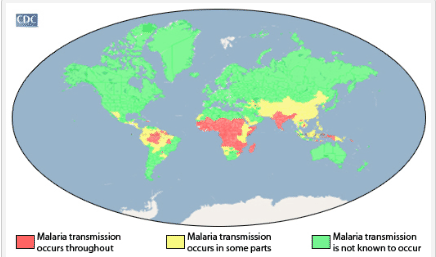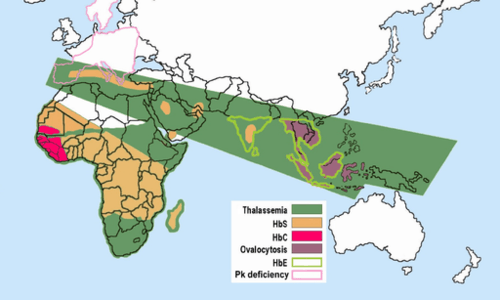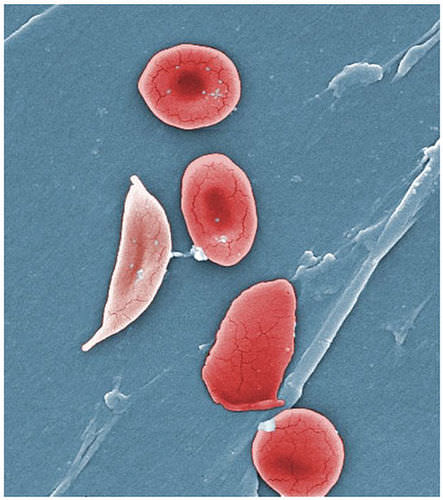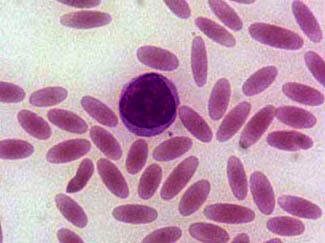8.7 疟疾适应
章节大纲
-
Itchy or Deadly?
::痒还是致命?A mosquito bite may just be itchy and annoying, but in some parts of the world, a mosquito bite is potentially deadly. Mosquitoes like the one in this photo can carry the parasite that causes malaria . This illness was the first documented example of a disease acting as an agent of in human . It has led to the evolution of several different adaptations to infections by malarial parasites. Why is malaria such a potent force of natural selection? And what human adaptations have evolved as a consequence? Read on to find out.
::蚊子的咬伤可能只是痒和烦人,但在世界的某些地区,蚊子咬伤可能是致命的。像这张照片中的蚊子那样的蚊子可以携带导致疟疾的寄生虫。这种疾病是作为人体诱因的疾病的第一个有记录的例子。它导致对疟疾寄生虫感染的几种不同适应的演进。为什么疟疾是自然选择的强大力量?人类的适应会演变成什么结果呢?继续阅读。What Is Malaria?
::什么是疟疾?Malaria is an infection of the red blood cells caused by a single-celled parasite in the genus Plasmodium. A parasite is an organism that lives in or on another organism, called the host , and causes harm to the host while benefiting from the relationship. Several of Plasmodium cause malaria in human hosts, but the species that causes the most cases and is also the most deadly is Plasmodium falciparum. The P . falciparum parasite is carried by Anopheles mosquitoes, which are vectors for the disease, as well as secondary hosts for the parasite. A vector is an organism (such as an insect) that spreads from host to host.
::疟疾是一种红细胞的感染,它是由原虫病原虫中的单细胞寄生虫引起的。寄生虫是一种生物,它存在于或附着另一个生物体中,称为宿主,在从关系中获益的同时对宿主造成伤害。几种原虫在宿主中造成疟疾,但造成大多数病例并且也是最致命的物种是恶性疟原虫。P. 恶性寄生虫是由寄生虫蚊携带的,这些寄生虫是该疾病的媒介,也是寄生虫的次要宿主。病媒是一种从宿主传播到宿主的有机体(如昆虫)。Transmission and Evolution of Malaria
::疟疾的传播和演变As shown in detail in the diagram , the malaria parasite has a complex that determines how malaria is transmitted. A female mosquito picks up the parasites when she feeds on the of an infected human host. The parasite goes through several life stages in the mosquito, and then travels to the mosquito’s salivary glands . When the mosquito bites another person, the parasite may be transmitted in the mosquito’s saliva to that person’s blood. The parasite goes through additional stages and multiplies in the human host. The cycle begins again when a mosquito bites the infected human host and picks up the parasites. In this way, the mosquito spreads the parasite from infected human hosts to new human hosts. A fairly large and a year-round mosquito population are needed to maintain continuous transmission of the parasite throughout the year so the disease does not die out. A disease that is present year-round within a population is considered endemic.
::如图所示,疟疾寄生虫的复杂情况决定了疟疾是如何传播的。 一只雌性蚊子在感染人体宿主的食用时会吸收寄生虫。 寄生虫在蚊子中经历了几个生命阶段,然后又去了蚊子的口腔。 当蚊子咬到另一个人时,寄生虫可能会在蚊子的唾液中传播到此人的血液中。寄生虫在人体宿主中会经历更多的阶段和倍增。当蚊子咬住感染人体宿主并吸收寄生虫时,这种循环又开始了。 这样,蚊子将寄生虫从感染的宿主传播到新的宿主。 需要相当大和一整年的蚊子人口来保持寄生虫的连续传播,这样这种疾病就不会消失。 一种在人口中持续一年的疾病被视为流行病。The malaria parasite requires both a human and a mosquito host.
::疟疾寄生虫既需要人类也需要蚊虫宿主。Close relatives of the human malaria parasite are common in chimpanzees, and some evidence suggests that P. falciparum malaria may have originated in gorillas. The parasite has probably been in existence for at least 50 thousand years. I t is unlikely, however, that malaria was an important human illness until about ten thousand years ago, when was invented . Before that time, all humans were hunter-gatherers, and their populations were small and mobile. With the advent of agriculture, human populations grew larger and more sedentary, allowing P. falciparum to become endemic and widespread.
::人类疟疾寄生虫的近亲在黑猩猩中很常见,一些证据表明,P. 恶性疟原虫疟疾可能起源于大猩猩,寄生虫可能已经存在至少5万年了。然而,直到大约一万年前发明了疟疾才可能是一种重要的人类疾病。在那之前,所有人类都是狩猎采集者,其人口是小而流动的。随着农业的到来,人类人口会增加,而且会更加定居,从而使P. 恶性疟原虫成为地方性和广泛性疾病。Malaria Symptoms, Prevention, and Treatment
::疟疾症状、预防和治疗Symptoms of malaria usually begin one to four weeks after an initial infection with P. falciparum . The classic symptom of malaria is the cyclical occurrence of debilitating fever, which occurs every 36 to 48 hours. Other common malaria symptoms include fatigue, vomiting, and headaches. In severe cases, malaria can cause yellow skin (jaundice), seizures, coma, or death. If not properly treated, people may have recurrences of the disease for months after the initial illness. Some people develop cerebral malaria, which is an often fatal P. falciparum infection of the brain .
::疟疾症状通常在P.falciparum初次感染后一至四个星期开始;疟疾的典型症状是周期性发烧,每36至48小时就发生一次;其他常见的疟疾症状包括疲劳、呕吐和头痛;在严重病例中,疟疾可导致黄皮(黄皮瘤)、癫痫、昏迷或死亡;如果得不到适当治疗,人们可能在最初患病数月后复发;有些人患有脑疟疾,经常是脑部致命的P.falciparum感染。The rate of infection with the malaria parasite can be reduced by breaking the cycle of transmission. This usually means preventing mosquito bites with the use of mosquito nets (shown ) and insect repellents, or reducing the size of the mosquito population around human habitations by spraying insecticides and draining standing . Several medications are available to prevent malaria in travelers going to areas where the disease is endemic. These drugs are costly and impractical to use in local populations in endemic regions. No effective vaccine for malaria exists, although efforts to develop one are ongoing. The recommended treatment for malaria is a combination of antimalarial drugs, but the parasites have evolved resistance to some of them.
::疟疾寄生虫的感染率可以通过打破传播周期来降低,这通常意味着通过使用蚊帐(shown)和昆虫驱虫剂来防止蚊子咬咬,或者通过喷洒杀虫剂和排水站来减少人类居住区蚊子人口的数量。在前往疟疾流行地区的旅行者中,可以提供几种药物来预防疟疾。这些药物费用高昂,在流行地区的当地居民中使用不切实际。没有有效的疟疾疫苗,尽管正在努力研制一种疫苗。建议的疟疾治疗是抗疟药物的结合,但寄生虫对其中一些药物的抗药性有所发展。Mosquito nets like this one protect people from mosquitoes while they sleep.
::像这样的蚊帐 保护人们睡觉时 免受蚊子的侵扰Geographic Distribution of Malaria
::疟疾地理分布As shown on the map , malaria is endemic in and subtropical regions in a broad band on either side of the equator, including much of Sub-Saharan Africa, South and Southeast Asia, and Latin America. Malaria is confined largely to tropical and subtropical regions because of the needs of the mosquito vectors. High rainfall, consistently high temperatures, and high humidity all favor large, year-round mosquito populations. The mosquitoes also need stagnant water in order to breed, because their larvae are .
::如地图所示,疟疾在赤道两岸,包括撒哈拉以南非洲、南亚和东南亚以及拉丁美洲大部分地区,在宽幅幅幅幅内,在疟疾和亚热带地区流行,疟疾主要局限于热带和亚热带地区,因为蚊虫病媒的需要。 高降雨量、持续高温和高湿度都有利于大量的全年蚊子。 蚊子也需要停滞的水来繁殖,因为幼虫是幼虫。Map showing the worldwide distribution of malaria in human populations
::显示疟疾在人类中在全世界分布分布的地图Malaria’s Toll on Human Populations
::疟疾对人类的伤害In 2015, there were 214 million cases of malaria worldwide, and its death toll was heavy. Malaria resulted in an estimated 438 thousand deaths, 90 percent of which occurred in Africa. Malaria most often kills young children. In addition, malaria in pregnant women is an important cause of spontaneous abortions, stillbirths, low birth weight, and infant mortality. Because of the excess early mortality and loss of fertility caused by malaria, it is a potent force of natural selection.
::2015年,全世界疟疾病例为2.14亿,死亡人数惨重,疟疾估计造成43.8万人死亡,其中90%发生在非洲,疟疾最经常导致幼儿死亡,此外,孕妇疟疾是自发堕胎、死胎、出生体重不足和婴儿死亡的重要原因之一,由于疟疾导致的早死率和生育力丧失,疟疾是自然选择的强大力量。Besides its direct toll in human suffering, malaria is commonly associated with poverty and has an extremely negative effect on economic . In Africa, malaria is thought to result in a loss of $12 billion a year. The loss is due to increased health care costs, lost ability to work, and negative effects on tourism.
::疟疾除了直接造成人类痛苦外,还通常与贫穷有关,对经济产生极为不利的影响。 在非洲,疟疾被认为每年损失120亿美元,损失的原因是保健费用增加、丧失工作能力以及对旅游业的负面影响。Genetic Adaptations to Malaria Parasites
::疟疾寄生虫基因适应Most human populations with a long history of endemic malaria have evolved genetic adaptations to malaria parasites because of the strong selective pressure. P. falciparum evolved in Africa and later spread to the New World. New World species of Anopheles mosquitoes, however, proved to be poorer vectors of the malaria parasite than Old World Anopheles species. Therefore, most of the human genetic adaptations to malaria described below arose in Old World populations, and are still present in relatively high frequencies in these populations.
::由于强烈的选择性压力,大多数具有长期疟疾地方病历史的人类人口已经对疟疾寄生虫进行了基因改造。P. Falciparum在非洲演变,后来传播到新世界。然而,事实证明,新的世界异种禽蚊子是比老世界异种更贫穷的疟疾寄生虫病媒。因此,下文描述的人类对疟疾基因改造大多发生在老世界人口,而且这些人口仍然处于相对高的频率。P. falciparum infects red blood cells, so most of the human genetic adaptations to the parasite are abnormalities that affect red blood cells. The principal component of red blood cells is hemoglobin , a that carries oxygen and gives blood their red color. Several abnormal hemoglobins have evolved that help protect against P. falciparum . The exact mechanisms by which the abnormalities confer resistance to malaria are not yet completely understood.
::P.falciparum感染了红血球,因此,人类对寄生虫的基因适应大多是影响红血细胞的异常现象,红血球蛋白的主要成分是血红蛋白,血红蛋白携带氧气并给血染红色,若干异常的血红蛋白有助于防止P.falciparum的发生,这些异常导致抗疟疾的确切机制尚未完全理解。Keep in mind that, with all of these genetic adaptations, there is a trade-off. Abnormal hemoglobins and other red blood cell abnormalities that protect against malaria generally produce anemia or other genetic diseases in a portion of the population, usually those who are homozygous for the abnormalities. These genetic diseases cause significant morbidity and may even cause death. W here malaria remains endemic, resistance to malaria generally improves fitness enough to outweigh the reduced fitness due to abnormal red blood cells or hemoglobin.
::需要注意的是,在所有这些基因适应性适应性条件下,都存在着一种权衡,即异常血红蛋白和其他防止疟疾的红细胞异常通常在部分人口(通常是异常同种人)中会产生贫血或其他遗传疾病,这些遗传疾病导致大量发病,甚至可能导致死亡。在疟疾仍然流行的地方,对疟疾的抗药性一般会提高健康程度,超过异常红细胞或血红蛋白导致的健康状况下降的程度。Abnormal Hemoglobins
::异常血红蛋白Geographic distributions of several hemoglobin abnormalities that confer resistance to malaria are shown on the map . They include hemoglobin S, hemoglobin C, hemoglobin E, and thalassemia. These abnormal hemoglobins have not been found in high frequencies anywhere else, except where malaria is endemic now or was endemic in the past. In some populations, abnormal hemoglobins may reach frequencies close to 50 percent.
::地图上展示了几种具有抗疟疾抗药性的血红蛋白异常的地理分布,其中包括血红蛋白S、血红蛋白C、血红蛋白E和地中海贫血。这些异常的血红蛋白在其他地方的高频率中没有发现,除非疟疾现在流行或过去流行,在有些人口中,异常的血红蛋白可能达到近50%的频率。Geographic distribution of abnormal hemoglobins and certain other genetic adaptations to malaria
::异常血红蛋白的地理分布和疟疾的某些其他遗传适应Hemoglobin S
::血红素 SHemoglobin S is the single most effective genetic adaptation to malaria. It occurs mainly in sub-Saharan Africa, but is also common in the Middle East and India. The for hemoglobin S and normal hemoglobin differ in just one nucleotide , due to a point mutation . Hemoglobin S causes red blood cells to take on a sickle shape (see image ) under certain conditions, causing sickle cell anemia in hemoglobin S homozygotes . Many children with hemoglobin S anemia die before the age of one year in sub-Saharan Africa. Hemoglobin S heterozygotes generally do not develop sickle cell anemia, and they also have greater resistance to malaria than normal homozygotes. Heterozygotes may still get malaria, but they are much less likely than normal homozygotes to die from it.
::血红蛋白S是唯一最有效的疟疾基因适应方法,主要发生在撒哈拉以南非洲,但也在中东和印度很常见。血红蛋白S和正常血红蛋白仅因突变点而在一个核核素中存在差异。血红蛋白S在某些条件下导致红细胞形成镰状形状(见图象 ) , 导致血红蛋白血球血清在血红细胞中出现贫血。许多患血红蛋白S贫血的儿童在撒哈拉以南的非洲1岁前死亡。血红蛋白S 血红蛋白血球Zeterozygotes通常不会发展镰状细胞贫血,而且对疟疾的抵抗力也比正常的同性同性恋还要大。 血红蛋白细胞仍然可能染上疟疾(见图象 ) , 但是他们比正常的同性病死的可能性要小得多。Normal and sickle cell red blood cells
::正常和镰状细胞红血细胞Hemoglobin C
::血红素 CHemoglobin C occurs primarily in parts of West and North Africa. It is due to a point mutation in the same nucleotide as hemoglobin S, but a different nucleotide is substituted. Hemoglobin C homozygotes suffer less severe anemia than hemoglobin S homozygotes, and they also have a 90 percent reduction in risk of malaria. Hemoglobin C heterozygotes do not have anemia and have about a 30 percent reduction in malaria risk.
::血红蛋白 C主要发生在西非和北非部分地区,其原因是与血红蛋白 S 相同的核糖酸的突变点,但代之以不同的核酸。 血红蛋白 C 共性甲状腺与血红蛋白 S 共性甲状腺相比,患严重性贫血症的程度要小于血红蛋白 S 共性甲状腺,疟疾风险也下降了90%。 血红蛋白 C 血色素没有贫血,疟疾风险也下降了30%左右。Hemoglobin E
::血红蛋白EHemoglobin E occurs mainly in South and Southeast Asia and is one of the most prevalent of the abnormal hemoglobins. It is also due to a point mutation, but in a different nucleotide than hemoglobins S and C. Both homozygotes and heterozygotes for hemoglobin E are relatively resistant to infection by P. falciparum, although homozygotes for the abnormal allele have anemia, as is true with all of the hemoglobin variants.
::血红蛋白E主要发生在南亚和东南亚,是异常血红蛋白中最普遍的一种,也是由于一种点突变,但与血红蛋白S和C不同,其核酸却与血红蛋白S和C不同。 血红蛋白E的同性人和异性人对P.falciparum的感染相对抗药性较高,尽管异常异性异性人的同性人有贫血症,正如所有血红蛋白变异物一样。Thalassemia
::地中海贫血Thalassemia is a type of inherited anemia caused by another abnormal hemoglobin. It occurs in a broad band extending from the Mediterranean region and parts of Africa, throughout the Middle East, India, Southeast Asia, and Melanesia. Different produce different forms of thalassemia in different populations, and the different forms vary in the severity of anemia they produce in homozygotes. Thalassemia homozygotes and heterozygotes both have resistance to malaria.
::地中海贫血是一种由另一种不正常的血红蛋白引起的遗传性贫血,它存在于地中海地区和非洲部分地区的宽幅中,遍及整个中东、印度、东南亚和美拉尼西亚。 不同的人口在不同的人群中产生不同形式的地中海贫血,不同形式的贫血在同卵石中产生,不同形式的贫血在同卵石中产生。 地中海血清同卵和异卵对疟疾都有抗药性。Other Red Blood Cell Abnormalities
::其他红血细胞Some populations have other red blood cell adaptations instead of, or in addition to, abnormal hemoglobins. Two of these — ovalocytosis and PK deficiency — are shown on the map above with the abnormal hemoglobins. Two other red blood cell abnormalities — G6PD deficiency and Duffy antigen negativity — are shown on the map .
::有些人群有其他的红细胞适应,而不是或除了异常的血红蛋白之外,还有两种血红蛋白,其中两种是卵巢细胞病和PK缺乏症,与异常的血红蛋白一起在上面的地图上显示,另外两种红细胞异常——G6PD缺乏症和Duffy抗原神经性——在地图上显示。HLA is an antigen on white blood cells that helps fight malaria parasites in the blood. It is the only major adaptation to malaria shown on this map that does not involve red blood cells.
::HLA是白细胞上的抗原,有助于防治血液中的疟疾寄生虫,是地图上唯一没有红细胞的疟疾主要适应方法。Ovalocytosis
::内分泌Ovalocytosis is an inherited condition in which an abnormal red blood cell protein causes the blood cells to take on an oval shape, instead of round. You can see a blood sample showing the oval red blood cells in this condition in the figure . Ovalocytosis occurs mainly in Southeast Asia. It is associated with protection against cerebral malaria in children.
::骨髓灰质疏松是一种遗传性疾病,在这种疾病中,异常的红细胞蛋白导致血细胞呈蛋白状,而不是圆形。你可以看到一个血样样本,在图中显示了处于这种状态的血浆红细胞。骨灰质疏松主要发生在东南亚,与防止儿童脑部疟疾有关。Oval-shaped red blood cells characteristic of ovalocytosis
::Oval形红血细胞,溶解细胞特征PK Deficiency
::PK 缺陷Pyruvate kinase (PK) is an that catalyzes an essential step in anaerobic . It is critical for ATP production in red blood cells. PK deficiency is the second most common red blood cell enzyme disorder. It occurs at relatively high frequencies in some European populations. PK deficiency has been shown to provide some protection against infection and replication of P. falciparum in human red blood cells.
::Pyruvate kyase (PK) 是一种催化厌氧症的重要一步。 它对于红血细胞的ATP生产至关重要。 PK缺乏是第二大常见的红血细胞酶紊乱症,发生在一些欧洲人口的相对高的频率上。 PK缺乏能提供某种保护,防止P.falciparum在人类红血细胞中的感染和复制。G6PD Deficiency
::G6PD 缺乏Glucose-6-phosphate dehydrogenase (G6PD) is an important red blood cell enzyme that is involved in metabolizing glucose . G6PD is present in all human cells, but is especially important in red blood cells. G6PD deficiency occurs in a broad swath from all around the Mediterranean through South and Southeast Asia. The deficiency is caused by a mutation on the X chromosome of the 23rd pair of , making it a sex-linked trait . It is the most common enzyme deficiency in humans. People with the deficiency develop a type of anemia called favism if they consume fava beans, but they also have lower parasite counts when infected with P. falciparum .
::G6PD存在于所有人类细胞中,但在红细胞中尤其重要。G6PD缺乏症发生在地中海各地的宽广地区,从南亚和东南亚蔓延至整个地中海。这种缺乏症是由第23对的X染色体突变造成的,因此是一种与性别有关的特性。它是人类最常见的酶缺乏症。如果食用法瓦豆,则缺血者会形成一种叫做favism的贫血症,但是在感染P. falsparum时,他们也有较低的寄生虫数量。Duffy Antigen Negativity
::Duffy Antigen Negativity( 立方体)Duffy antigen negativity refers to the lack of the Duffy antigen receptor on red blood cells. It occurs mainly in western sub-Saharan Africa. It provides relative, but not absolute, resistance to infection by Plasmodium vivax , another malaria parasite that is found in Africa.
::Duffy 抗原净性是指红细胞缺乏Duffy 抗原受体,主要发生在撒哈拉以南非洲西部,它相对而非绝对地抵抗在非洲发现的另一种疟疾寄生虫 -- -- 病原体 -- -- 的感染。Summary
::摘要-
Malaria is an infection of the red blood cells caused by protozoan parasites in the genus
Plasmodium.
The species
Plasmodium
falciparum
causes the most cases of malaria and is also the most deadly. Humans are hosts to the parasite, as are
Anopheles
mosquitoes, which are also vectors for malaria, meaning that they spread the pathogen from human host to human host.
::疟疾是原生虫寄生虫在genus Plasmodium体内引起的红细胞感染,恶性疟原虫是疟疾病例最多的病原体,也是最致命的。 人类是寄生虫的宿主,阿诺斐尔蚊子也是疟疾的病媒,这意味着它们把病原体从宿主传播到宿主。 -
Symptoms of malaria include recurrent debilitating fevers, as well as fatigue, vomiting, and headaches. Prevention efforts include reducing the risk of exposure to mosquito bites and the size of mosquito populations. There is no vaccine to prevent malaria, but the disease can be treated with a combination of drugs.
::疟疾的症状包括经常发衰竭性热以及疲劳、呕吐和头痛,预防工作包括减少蚊子被咬的风险和蚊子人口数量,没有预防疟疾的疫苗,但这种疾病可以混合药物治疗。 -
Malaria is endemic in tropical and subtropical regions of the world. In 2015, there were 214 million cases of malaria worldwide and an estimated 438 thousand deaths from malaria, mainly in Africa and primarily in young children. Malaria causes not only excess early mortality, but also loss of fertility, making it a potent agent of natural selection.
::疟疾在世界热带和亚热带地区流行,2015年,全世界疟疾病例为2.14亿,疟疾死亡人数估计为43.8万,主要在非洲,主要是幼儿,疟疾不仅造成过早死亡率过高,还造成生育率丧失,使其成为自然选择的有力因素。 -
Most Old World human populations with a long history of endemic malaria have evolved genetic adaptations to malaria parasites. Most of the adaptations are abnormalities of red blood cells or hemoglobin, the oxygen-carrying protein that is the principal component of red blood cells. The genetic adaptations also produce anemia in a portion of the populations where the adaptations are prevalent.
::具有长期疟疾地方病历史的多数老世界人类对疟疾寄生虫进行了基因改造,大多数适应是红血细胞或血红蛋白的异常现象,血红蛋白是红血细胞的主要成份,基因改造也使部分适应流行的人口产生贫血症。 -
Abnormal hemoglobins that confer resistance to malaria include hemoglobin S, hemoglobin C, and hemoglobin E. Thalassemia is an inherited anemia caused by another hemoglobin abnormality that also confers resistance to malaria.
::对疟疾产生抗药性的异常血红蛋白包括血红蛋白S、血红蛋白C和血红蛋白E。 血红蛋白贫血是一种遗传性贫血症,由另一种血红蛋白异常现象造成,也会导致对疟疾的抗药性。 -
Other red blood cell abnormalities that confer resistance to malaria include ovalocytosis, pyruvate kinase (PK) deficiency, glucose-6-phosphate dehydrogenase (G6PD) deficiency, and Duffy antigen negativity.
::其他导致抗疟疾的红细胞异常情况包括:卵巢细胞病症、气压动脉(PK)缺乏症、葡萄糖-6-磷酸盐脱氢酶(G6PD)缺乏症和Duffy抗原中性。
Review
::回顾1. What is malaria?
::1. 什么是疟疾?2. Explain how malaria is transmitted.
::2. 解释疟疾是如何传播的。3. Describe the symptoms of malaria.
::3. 描述疟疾的症状。4. Why is controlling Anopheles mosquitoes currently the best way to prevent malaria in populations where the disease is endemic?
::4. 为什么目前控制驱虫蚊子是预防疟疾流行地区的疟疾的最佳途径?5. Summarize the geographic distribution of endemic malaria worldwide. What explains this distribution?
::5. 概述全世界疟疾流行的地理分布,为什么这种分布?6. Why do genetic adaptations to malaria generally involve red blood cells?
::6. 为什么对疟疾的基因适应通常涉及红细胞?7. Identify genetic adaptations to malaria parasites that are abnormal hemoglobins. Which abnormal hemoglobin is the single most effective genetic adaptation to malaria?
::7. 确定对异常血红蛋白的疟疾寄生虫的基因适应:哪一种异常血红蛋白是唯一最有效的疟疾基因适应?8. List four additional red blood cell abnormalities that confer resistance to malaria.
::8. 列出另外四种导致抗疟疾的红色血细胞异常现象。9. Why do you think that the adaptations to malaria described here are not prevalent in areas that do not have malaria?
::9. 你为何认为本文所述的疟疾适应措施在没有疟疾的地区并不普遍?10. Explain why the advent of agriculture may have increased the influence of malaria on human evolution.
::10. 解释为什么农业的出现可能增加了疟疾对人类演变的影响。11. A disease that is endemic...
::11. 一种地方性疾病...a. has spread worldwide
::a. 扩散到全世界b. usually kills most of the people that it infects
::b. 通常杀死其感染的大多数人c. is present year-round in a population
::c. 在某一人口中是全年居民。d. is passed from animals to humans
::d. 从动物传给人类12. Explain why, in general, heterozygotes for hemoglobin S have greater fitness than either type of homozygote in areas with malaria.
::12. 解释为什么在一般情况下,血红蛋白 S的异体阳性人比疟疾地区这两种同体人更健康。13. Which genetic adaptation to malaria is due to a point mutation?
::13. 疟疾的基因适应是因点变异造成的?a. hemoglobin S
::a. 血红蛋白 Sb. hemoglobin E
::b. 血红蛋白Ec. hemoglobin C
::c. 血红蛋白Cd. all of the above
::d. 以上所有情况14. True or False: There is only one species of parasite that can cause malaria in humans.
::14. 真实或假:只有一种寄生虫可对人类造成疟疾。15. True or False: The P . falciparum parasite is a vector for malaria.
::15. 真实或假:P. 恶性疟原虫是疟疾的媒介。Explore More
::探索更多You can learn more about efforts to eradicate malaria by watching this passionate and sometimes humorous TED talk by Microsoft founder Bill Gates. His foundation is one of the major global leaders in the campaign against malaria, and he hopes to solve this and some of the world's other biggest problems using a new kind of philanthropy. In this video, Gates asks the viewer to consider two big questions and how we might answer them.
::通过观看微软创始人比尔·盖茨(Bill Gates)的充满激情和有时幽默的TED演讲,你可以更多地了解消除疟疾的努力。他的基金会是防治疟疾运动的主要全球领导者之一,他希望用一种新的慈善事业来解决这个问题和世界上其他一些最大的问题。在这段影片中,盖茨请观众考虑两个大问题,以及我们如何回答它们。Learn about the effects of s ickle c ell anemia on athlete performance in this video :
::了解镰状细胞贫血对运动员表现的影响: -
Malaria is an infection of the red blood cells caused by protozoan parasites in the genus
Plasmodium.
The species
Plasmodium
falciparum
causes the most cases of malaria and is also the most deadly. Humans are hosts to the parasite, as are
Anopheles
mosquitoes, which are also vectors for malaria, meaning that they spread the pathogen from human host to human host.
